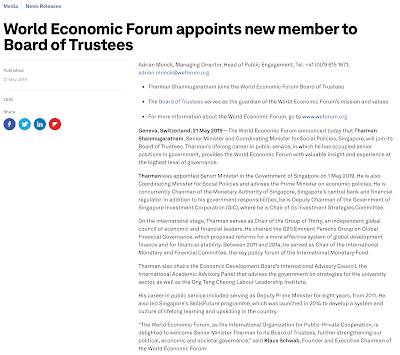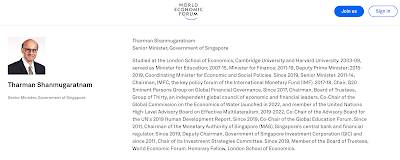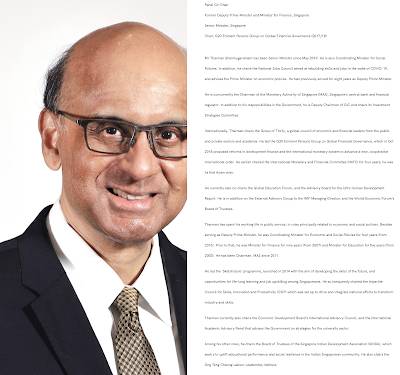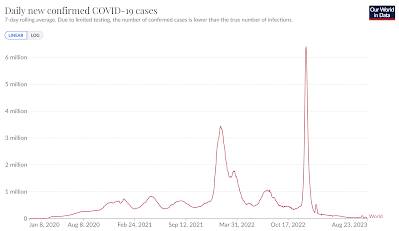
This article was last updated on August 31, 2023
Canada: ![]() Oye! Times readers Get FREE $30 to spend on Amazon, Walmart…
Oye! Times readers Get FREE $30 to spend on Amazon, Walmart…
USA: ![]() Oye! Times readers Get FREE $30 to spend on Amazon, Walmart…
Oye! Times readers Get FREE $30 to spend on Amazon, Walmart…
Vaccinating the World – The Link Between the Idiocracy and the Never-dying COVID-19 Pandemic Narrative
According to CNA formerly known as Channel NewsAsia, a leading Singapore-based news channel which is owned by the nation’s national public broadcaster Mediacorp, the Senior Minister of the Republic of Singapore Tharman Shanmugaratnam made the following comments at a joint press conference held with World Health Organization’s Director-General Tedros Ghebreyesus on August 25, 2023:
“We have to move away from thinking about funding for global health security in terms of foreign aid, towards thinking about it as a strategic investment that all nations must make, not only for the good of the global community but because it is in each nation’s self-interest.“
To that end, he added this in light of the supposed ongoing COVID-19 pandemic:
“The first and most urgent priority is to implement the action plan set out by the WHO, IMF and their multilateral partners to vaccinate at least 60 per cent of every country’s population over the next year….
The resources that need to be mobilised are larger than nations have collectively been willing to commit in the past. But they are very small investments compared to the costs of prolonging the current pandemic, and tiny compared to the costs of the future pandemics that we can avoid.“
Now, you may think that, outside of Singapore, one of the world’s smallest and least influential nations, Mr. Shanmugaratnam would have no influence. You would be wrong in making that assumption given this:
…and this:
So, the man who wishes to see 60 percent of every nation in the world vaccinated against COVID-19 over the next year is a World Economic Forum insider and just happens to be the Co-Chair of the G20’s panel Financing the Global Commons for Pandemic Preparedness and Response which was established in January 2021 as shown here:
The panel that he heads has made the following recommendations:
https://pandemic-financing.org/report/high-level-summary/
1.) nations must commit to a new base of multilateral funding for global health security based on pre-agreed and equitable contribution shares by advanced and developing countries. This will ensure more reliable and continuous financing, so the world can act proactively to avert future pandemics, and not merely respond at great cost each time a new pandemic strikes.
This must include a fundamentally new way of financing a reformed and strengthened WHO, so that it receives both enhanced and more predictable resources. The Panel joins the call by the IPPPR for assessed contributions to be increased from one-quarter to two-thirds of the budget for the WHO’s base program, which will effectively mean an addition of about US$1 billion per year in such contributions.
2.) global public goods must be made part of the core mandate of the International Financial Institutions (IFIs) – namely the World Bank and other multilateral development banks (MDBs), and the International Monetary Fund (IMF). They should draw first on their existing financial resources, but shareholders must support timely and appropriately sized replenishments of their concessional windows and capital replenishments over time to ensure that the greater focus on global public goods is not at the expense of poverty reduction and shared prosperity.
3.) a Global Health Threats Fund mobilizing US$10 billion per year should be established, and funded by nations based on pre-agreed contributions. This new Fund, at two-thirds of the minimum of US$15 billion in additional international resources required, brings three necessary features into the financing of global health security. First, together with an enhanced multilateral component of funding for the WHO, it would provide a stronger and more predictable layer of financing. Second, it would enable effective and agile deployment of funds across international and regional institutions and networks, to plug gaps swiftly and meet evolving priorities in pandemic prevention and preparedness. Third, it would also serve to catalyze investments by governments and the private and philanthropic sectors into the broader global health system, for example through matching grants and co-investments. The Fund’s functions should be defined to ensure that it complements rather than substitutes for financing of the MDBs’ concessional windows and the existing global health organizations.
4.) multilateral efforts should leverage and tighten coordination with bilateral ODA (Official Development Assistance), and with the private and philanthropic sectors. Better coordination within country and regional platforms will have greater impact in reducing pandemic risks, and enable better integration with ongoing efforts to tackle endemic diseases and develop other critical healthcare capabilities. It will be important to ensure that ODA flows mobilized for pandemic preparedness add to and do not divert resources from other priority development needs.
In addition, the group states the following:
“Governments must collectively commit to increasing international financing for pandemic prevention and preparedness by at least US$75 billion over the next five years, or US$15 billion each year, with sustained investments in subsequent years.
The Panel assesses this to be the absolute minimum in new international investments required in the global public goods that are at the core of effective pandemic prevention and preparedness. The estimate excludes other investments that will contribute to resilience against future pandemics while benefiting countries in normal times. These complementary interventions – such as containing antimicrobial resistance, which alone will cost about US$9 billion annually, and building stronger and more inclusive national health and delivery systems – provide continuous value. Furthermore, the estimated minimum international investments are based on conservative assumptions on the scale of vaccine manufacturing capacity required in advance of a pandemic. Larger public investments to enable enhanced manufacturing capacity will indeed yield much higher returns.
The minimum additional US$15 billion per year in international financing for pandemic preparedness is still a significant increase. It is a critical reset to a dangerously underfunded system. “
So there you have it. The G20 affiliated group which is charged with dealing with pandemics is headed by a man who plays a leadership key role at the World Economic Forum. He is only too willing to spend your tax dollars to ensure that the response to the next pandemic follows the recommendations of the World Health Organization and the G20 panel for Financing the Global Commons for Pandemic Preparedness and Response. This man is recommending that over the next year, 60 percent of the world should be vaccinated against COVID-19. Given that only 32.5 percent of people in low-income nations have received at least one dose of the vaccines which have proven to be only marginally effective and that daily new confirmed COVID-19 cases have done this:
….the 60 percent vaccination target for all nations in the world is a tall and likely ineffective/unncessary order but one that the global ruling class wishes to impose on the rest of us. After all, the globalists including those affiliated with the World Economic Forum just can’t let the COVID-19 narrative die a much-deserved death.
The global idiocracy is alive and well.




Be the first to comment